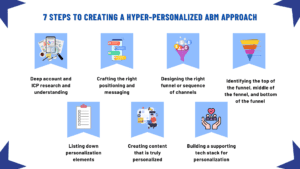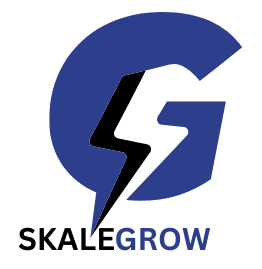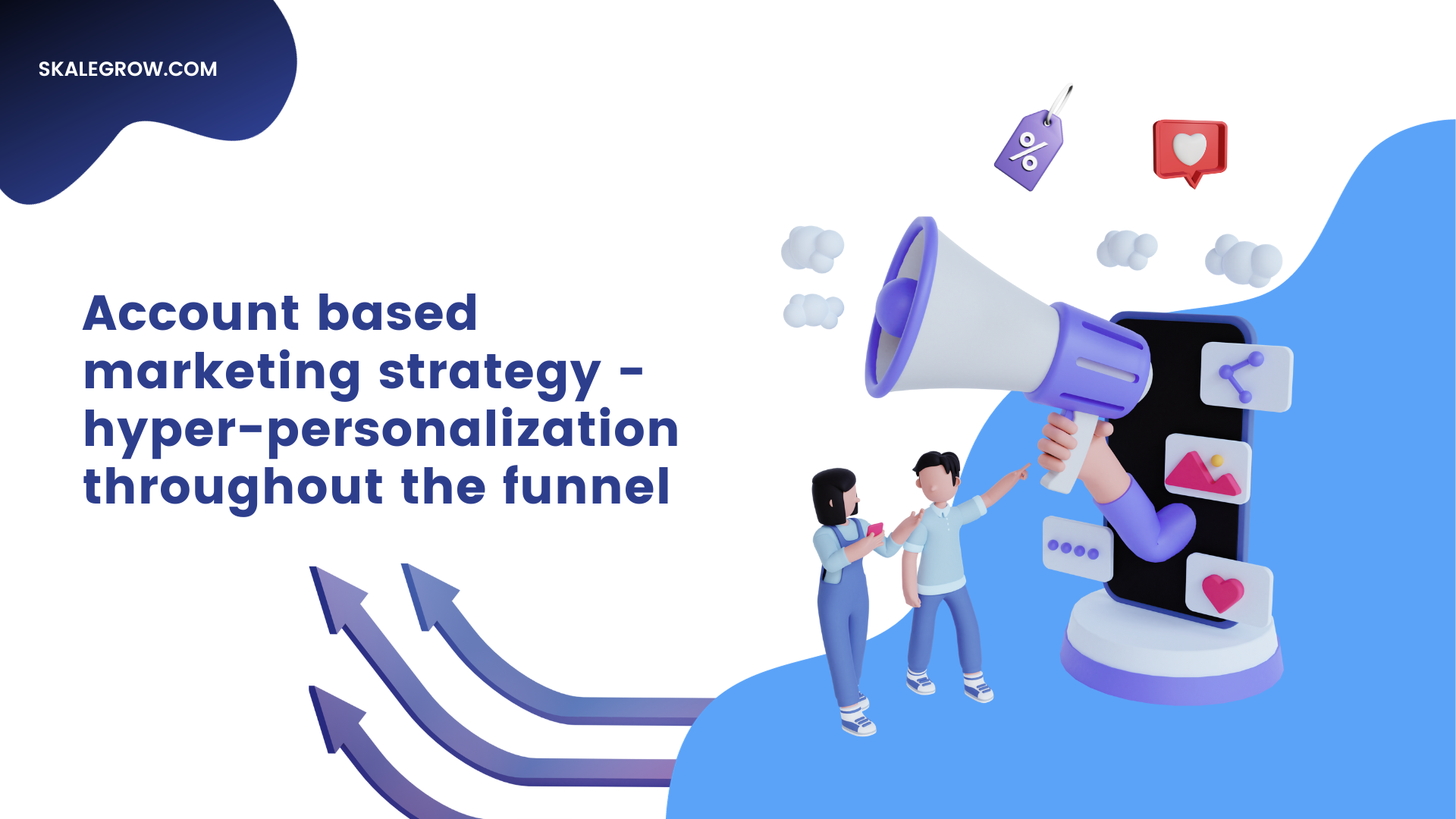This article was originally published in the Elevate Your Marketing newsletter and has been repurposed and republished here with the author’s permission. Here is the link to the original article.
Account Based Marketing or ABM continues to be the focus for many B2B companies in 2023. While spray and pray methods bring in a large volume of leads, they fail the test in meeting the desired quality. Hence, there is no surprise why ABM and ABX (Account Based Experience) are creating a buzz.
But is ABM only about sending email campaigns, conducting roundtables, and running LinkedIn ads? Is personalization limited to using the recipient’s first and last names in emails?
In this blog post, we shatter many of these conventional beliefs about ABM. More importantly, we will discuss how to ‘think ABM’ across the marketing and sales funnel (and not just the middle or bottom of the funnel). In that sense, this blog post touches upon multiple dimensions of ABM. So, buckle yourself up for an enriching read.
Before we start
ABM is a topic that I have touched upon multiple times in other articles. I recommend that you check them out if you wish to learn more about some of the other dimensions of ABM. Here are the links to the articles:
What is account based marketing and what is an ABM platform?
The benefits of using an ABM platform
Why [And How] ABM And SEO Should Work Together
Account Based Marketing Strategies: 12 Ways To Find Target Accounts
Setting the context in detail
To most B2B marketers today, ABM is about sending emails to their target accounts. At best, they would follow up those emails with cold calls.
Then there are more advanced B2B marketers who think a little beyond emails. They start with creating awareness among their accounts – mostly using LinkedIn ads. They also leverage offline events to set up meetings with potential customers. These techniques are combined with emails and cold calling to continue nurturing and engaging the leads.
While the second method is more effective than the first, that too lacks the ‘reach’ the modern B2B buyer journey demands (check out the article on multi-dimensional funnel to learn how the modern B2B buying journey has changed).
A Gartner research finds that when B2B buyers are considering a purchase‚ they spend only 17% of that time meeting with potential suppliers. In addition, B2B buyers are increasingly turning to communities, organic social media content, peer suggestions, etc., for selecting a supplier or vendor.
This shift in buying behavior requires you to be ‘present’ where your potential customers are. And that’s not limited to LinkedIn ads or emails. You need to ‘expand the horizon’ of your ABM efforts to create a marketing plan that will help you to get seen on those platforms.
Expanding the horizon of Account Based Marketing
When we discuss ABM, the narrative is usually around making your efforts super-targeted. It involves selecting a narrow set of accounts and running campaigns to them. While this works for the middle and bottom of the funnel, it is not as effective for creating demand at the top of the funnel. And we see this as a huge gap in ABM today.
This is not to say that you should stop having that laser-sharp focus. This is rather to force you to think in the direction of expanding your target bucket from specific accounts to certain types of accounts when it comes to creating demand.
Let me explain.
In this approach, you do two things in parallel:
- Continue with your targeted approach to a select list of accounts
- Reach these and similar accounts that might be interested in what you offer using other channels like communities, organic social media, LinkedIn Live, etc.
What do I mean by hyper-personalization here?
Let’s not deviate from the title of this article. As I mentioned, the idea of this new approach is to plan every marketing activity and create every piece of content as if they are targeted at your ideal customer profile or account. Even this is ABM.
But the question is, how can you personalize your campaigns and content for all these accounts?
The thing is, personalization doesn’t always have to be for one person. I think the concept of writing copy or creating content for 1 person – that many copywriters are a big proponent of – is not a scalable approach. You can personalize for a segment of your audience or a group of accounts too. Hyper personalization means you personalize the message to all the accounts or individuals you want to target in all possible ways. We will look at more examples of this as we go into the details.
Hyper-personalized ABM throughout the funnel
Whenever I describe an approach, I break it down into multiple easy-to-understand steps. Let us do it the same way this time as well. As we see it, there are 7 steps to creating a hyper-personalized ABM approach for the entire marketing and sales funnel:

7 steps to creating a hyper-personalized ABM approach
- Deep account and ICP research and understanding
- Crafting the right positioning and messaging
- Identifying the top of the funnel, middle of the fennel, and bottom of the funnel channels for ‘showing up.’
- Designing the right funnel or sequence of channels
- Listing down personalization elements
- Creating truly personalized content
- Building a supporting tech stack for personalization
1. Deep account and ICP research and understanding
This is fundamental to not just ABM but almost every activity in marketing and sales, and business in general. But here, one of the key objectives is to identify elements of personalization by deeply understanding your potential customers.
Some of the pieces of information you need to find out and list down are:
- Firmographic criteria of your target accounts: revenue, industry, sub-industry, region, number of employees, etc.
- Funding/IPO details (relevant for startups and early-stage businesses)
- IT budget (relevant in the case of a company selling IT solutions): this involves defining a range – say, companies with a minimum IT spend of $5M per year.
- The key decision makers and influencers in your target accounts.
- Their pain points with respect to what problem your products or services solve: you can have different pain points stated for different categories or segments. This could also change based on the individual persona you target.
Remember, here we are not going deep into every individual account. Rather, we are trying to find segments of your target audience with common characteristics and group them into logical categories.
2. Crafting the right positioning and messaging for account based marketing
This, again, is not an activity specific to ABM alone. But this is one of the foundational elements of account based marketing. If you have to hyper-personalize your ABM efforts, you need to first know where your products or services stand in the market.
- What are the unique features and benefits your solution brings to the table?
- How will they positively impact your customers’ lives?
- Why is it better than what some of your competitors offer?
You need to answer these questions to position yourself in the market so that you stand out. As you do this, keep step #1 in mind. In fact, you can perform both steps in parallel.
If your solution requires you to position it differently for different target segments, do that too.
3. Identifying the top of the funnel, middle of the funnel, and bottom of the funnel channels for ‘showing up’
When we say you need to find channels for each stage of the funnel, it doesn’t necessarily mean you need to bucketise them. Many a time, there is a thin line between them. In addition, the multi-dimensional funnel doesn’t visualize the funnel in 3 different layers.

A more convenient and logical way of looking at a funnel is to categorize it into demand gen and demand capture layers. When you attempt to hyper-personalize ABM campaigns, you can do the same.
Among all the demand gen and capture channels, identify those where your prospects hang out. Personalized ABM is also about identifying those unique platforms and creating content and campaigns that meet the needs of that channel.
For example, if you discover that your prospects are active podcast listeners, you can either host your own podcast or have your founders and leaders appear on others. You need to be selective about the podcasts and topics you choose.
Let us understand this through an example.
Imagine your company is into selling packaging solutions for warehouses. Instead of using a topic like ‘how packaging transforms multiple industries’, a topic focused on the hyper-personalized ABM approach is what you need to pick. Examples include:
- How warehouses can improve efficiency by up to 50% by using the right packaging solutions
- How innovative packaging solutions contribute to the Industry 4.0 revolution
- Packaging best practices for reducing wastage in warehouses
Now let us get back to identifying the right channels.
The only difference when you look at selecting channels with an ABM eye is that you need to prioritize those channels likely to have a larger percentage of your target persona as users. This exact information is not available precisely in most cases. So you need to make a scientific guess.
Let us consider an example of a company that sells networking hardware solutions to businesses. An online community on Discord for software engineers is not a great channel choice in this case. This is because, though some of the members of the community could be influencers for the company’s solutions, a vast majority will not be.
On the other hand, a community for cybersecurity professionals is far more relevant, given that networking solution sellers also need to take into confidence security professionals in the prospect organization.
The idea is that even if you don’t find a perfect community or channel, you can still find related ones that might be a fit for you (like the cybersecurity example).
Here are the other things you need to keep in mind when it comes to selecting your marketing channels for ABM across the funnel:
- Go for quality rather than quantity – for instance, if you plan to run promotions in an online magazine, dive deep into the firmographic and demographic characteristics of their audience rather than merely looking at the size of the email list or the number of social media followers.
- Pick channels where high-intent buyers are likely to hang out – for example, Instagram is not great for B2B businesses when it comes to generating pipeline.
- Choose channels where the platform natively offers some form of segmentation. If the platform offers this organically without paid ads, nothing like it. LinkedIn groups and online communities on Slack and Discord are examples of this.
- Choose channels that support multiple content formats that make it easy for people to share content. Nowadays, you would have noticed this meta trend where more and more tools are becoming all-in-one content platforms. Twitter introducing notes and Linkedin’s newsletter feature are all examples of this. So most platforms support multiple content types. But avoid those that don’t.
The rest is about following general best practices that will help you find the right marketing channels. The article given below will help you with this:
Content Distribution 101 – How To Find The Perfect Mix Of Marketing Channels
4. Designing the right funnel or sequence of channels
This has two sides to it. The first is the concept of the multi-dimensional funnel we already discussed. The modern B2B funnel has multiple entry and exit points. It is characterized by non-linear customer journeys.
The second is understanding that demand capture can work effectively only if you generate the required demand at the top of the funnel.
Using LinkedIn or Google ads awareness campaigns to attract traffic to your website is not the only way to generate demand. The funnel starts right when a potential customer in your target bucket sees your content. It can be on a social media platform, a talk your CEO delivered, or an industry roundtable.
You need to optimize your content and campaigns to suit this new funnel. Read this along with the concept of expanding the horizon of ABM. While on one side you try to attract the attention of the narrow set of accounts, you need to feed in a highly relevant set of accounts – that are not part of your list yet – through the top of the funnel.
5. Listing down personalization elements
This is where personalization gets serious. We spoke earlier about why it is important to create personalization elements not just for the 300 accounts but for the expanded horizon too.
In addition to the elements we discussed in step #1, here are a few more items that can help hyper-personalize your ‘expanded ABM’ approach:
- Industry trends – think about whether you can use a tool like xIQ to curate content in your email campaigns based on industry trends,
- Name of the recipient, recipient company name, recipient company description, recipient company products & services, etc.
- Function-specific trends are helpful if you are segmenting your audience based on job roles. Say if you are targeting CIOs (Chief Information Officers), technology challenges that modern-day CIOs are facing could be added to your campaigns. Similarly, you can do the same for the other segments as well. You can also have different pain points for each function as we discussed in step #1.
Note: Remember, personalization is not just about dynamically changing the content of your email based on the recipient. There are other forms of personalization such as website personalization (think about Adobe Target or Idio for example), video personalization (have you checked out Hippo Video or Hyperise?), etc. So the more information you have about your target customers, the better.
6. Creating truly personalized content for account based marketing
Nothing in marketing survives without content. Isn’t it? And that’s true for ABM as well. But how do you truly personalize the content for your ABM efforts?
One, of course, is changing the name and other details of the recipient dynamically based on who they are. We all know about this. Whether you are using an email automation tool, Linkedin Inmail, or a LinkedIn outreach automation tool like Dripify, this technique has become quite common now. Everyone is using it. It doesn’t help you stand out anymore.
What are the other possible ways of hyper-personalizing your ABM efforts?
Let’s explore.
We already discussed how website personalization could help. If you can modify your website content based on the characteristics of the visitor, that can improve engagement and conversions.
You might ask – how is this even ABM?
It contributes to your ABM efforts because when you bring your dream accounts to your website (using any channel), you make the content look like it is made just for them. It enhances their overall experience – thereby improving the probability of conversion. We also touched upon how you can personalize video content for every user.
Next, let us look at some of the other ways in which you can hyper-personalize your ABM efforts using content throughout the marketing funnel, especially the top of the funnel:
(As we list these down, you need to keep in mind that when we say personalization, we are referring to personalizing content – and marketing in general – not just for individuals but for segments or cohorts of your target audience).
- While you create generic content targeted at everyone on one side, make sure you create content for specific cohorts. What I mean here is, say, you created a video on how businesses can safeguard themselves from cybersecurity threats, you should also consider creating one on a topic that goes like: ‘How CISOs can effectively prepare for modern-day cybersecurity threats.’
- Implement the previous step at scale. Have you heard about the HubSpot podcast network? The company created it to make it the go-to destination for business knowledge. Similarly, can you create a web of content (podcasts, YouTube channels, online communities) where each medium or platform talks to separate segments of your targeted audience? If you have the resources, you should. Isn’t that hyper-personalized ABM at scale?
- Sending personalized video messages. This is an example of hyper-personalized ABM at the middle and the bottom of the funnel. You can use tools like Bonjoro or Hippo video to send personalized messages as a cold email or LinkedIn message, or even upon onboarding a new customer (using video messages helps to improve engagement and reduce customer churn).
- Using direct mail as a method to create and capture demand. Tools like Sendoso or The Mailworks will help you stand out by combining the best of direct mail and digital technology. This can be done at the funnel’s top, middle, or bottom.
7. Building a supporting tech stack for personalization
I think this doesn’t need a further explanation. Go back and look at all the tools and platforms we discussed today. From LinkedIn to Google ads and Sendoso to xIQ, there is a wide variety of tools you can use to enhance the results of your ABM activities. Some of the other types of tools that can be a part of the mix are intent intelligence tools (like Demandbase, 6sense, or Terminus), person-based advertising tools and techniques (Influ2, Google ads customer match campaigns, Facebook custom lists, etc), and revenue attribution and analytics tools like Factors AI.
Will the deprecation of third-party cookies affect hyper-personalized ABM?
The saying that data is the new oil will be more true once Google deprecates third-party cookies completely in 2024. Personalization tools like Evergage, Adobe Target, Sitespect, etc., will find it more difficult to collect information about website visitors. Hence website personalization is going to be somewhat affected by the change. Display ad platforms might also face some challenges targeting with limited user data. However, if you have a rich first-party database, personalization based on that is very much possible.
At the same time, this change doesn’t affect some of the new ideas we discussed today for hyper-personalized ABM. In this approach, we are focusing on cohorts of audiences based on easily identifiable characteristics like a community, social media group, or media company (think about the cybersecurity community example we discussed earlier).
Final words
I know we went against the conventional thoughts of ABM in this article. That was because I am getting a sense that many companies are making their ABM efforts so narrow that they forget to focus on a wider net of accounts that might be interested in buying from them.
There are two angles to look at this:
- Not all accounts in your target list are in the market to buy your solutions. So even if you have a narrow list of 300 accounts to target, probably only 100 of them are interested in exploring what you sell today.
- This would also mean that you need to think beyond these 300 accounts. And this shouldn’t stop at creating a look-alike list. You need to target thousands of other accounts as if they are part of your target account list.
The hyper-personalized ABM approach I proposed in this article goes much beyond personalizing campaigns to the 300 accounts. Instead, you expand your horizon to create demand among relevant accounts that otherwise would not have been on your radar.
And it is okay not to have the complete list of all those accounts. You already know the 300 very well. What’s important is to create awareness of your solutions among them and make them come to you when they are ready.
Hope you found this read insightful.
Skalegrow – B2B account based marketing agency
With marketing getting tougher and tougher, every wrong foot you make might hamper your growth. What you need is the right guidance and a helping hand. This is where Skalegrow can make a sea of difference.
Skalegrow helps IT, tech, SaaS, and embedded systems companies leverage new-age marketing tactics to grow their business. Check out the below intro video to learn more about what Skalegrow brings to the table:
About the author

Naseef KPO is the Founder and CEO of Skalegrow. He comes with rich experience across multiple areas of B2B marketing including content marketing, demand generation, SEO, account-based marketing, marketing analytics, revenue attribution, marketing technology, etc. He writes thought-provoking and relevant articles on The Skalegrow Blog and his weekly LinkedIn newsletter Elevate Your Marketing.
Prior to starting Skalegrow, Naseef led large marketing teams in multi-million dollar B2B organizations where he made significant contributions to the topline growth of the business. He has also appeared on numerous podcasts where he shared his thoughts on trending marketing topics such as the application of AI in marketing, startup marketing, ABM, and B2B content marketing, just to name a few. Being the founder of Skalegrow, he is currently focusing on helping its clients stay ahead of their competition by using innovative yet practical marketing tactics.
You can connect with Naseef KPO on LinkedIn.


